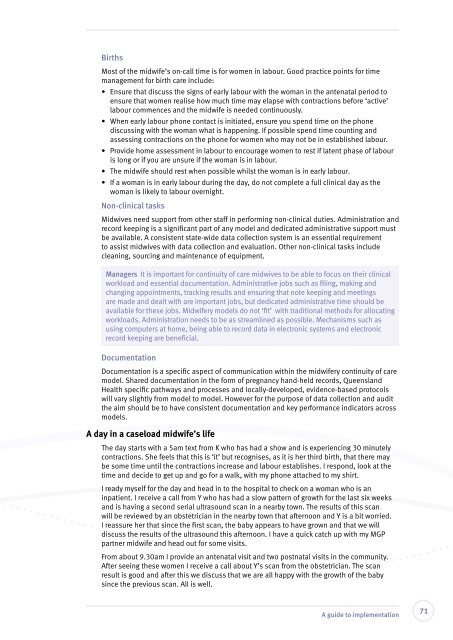Delivering continuity of midwifery care to Queensland women
Delivering continuity of midwifery care to Queensland women
Delivering continuity of midwifery care to Queensland women
Create successful ePaper yourself
Turn your PDF publications into a flip-book with our unique Google optimized e-Paper software.
Births<br />
Most <strong>of</strong> the midwife’s on-call time is for <strong>women</strong> in labour. Good practice points for time<br />
management for birth <strong>care</strong> include:<br />
• Ensure that discuss the signs <strong>of</strong> early labour with the woman in the antenatal period <strong>to</strong><br />
ensure that <strong>women</strong> realise how much time may elapse with contractions before ‘active’<br />
labour commences and the midwife is needed continuously.<br />
• When early labour phone contact is initiated, ensure you spend time on the phone<br />
discussing with the woman what is happening. If possible spend time counting and<br />
assessing contractions on the phone for <strong>women</strong> who may not be in established labour.<br />
• Provide home assessment in labour <strong>to</strong> encourage <strong>women</strong> <strong>to</strong> rest if latent phase <strong>of</strong> labour<br />
is long or if you are unsure if the woman is in labour.<br />
• The midwife should rest when possible whilst the woman is in early labour.<br />
• If a woman is in early labour during the day, do not complete a full clinical day as the<br />
woman is likely <strong>to</strong> labour overnight.<br />
Non-clinical tasks<br />
Midwives need support from other staff in performing non-clinical duties. Administration and<br />
record keeping is a significant part <strong>of</strong> any model and dedicated administrative support must<br />
be available. A consistent state-wide data collection system is an essential requirement<br />
<strong>to</strong> assist midwives with data collection and evaluation. Other non-clinical tasks include<br />
cleaning, sourcing and maintenance <strong>of</strong> equipment.<br />
Managers It is important for <strong>continuity</strong> <strong>of</strong> <strong>care</strong> midwives <strong>to</strong> be able <strong>to</strong> focus on their clinical<br />
workload and essential documentation. Administrative jobs such as filing, making and<br />
changing appointments, tracking results and ensuring that note keeping and meetings<br />
are made and dealt with are important jobs, but dedicated administrative time should be<br />
available for these jobs. Midwifery models do not ‘fit’ with traditional methods for allocating<br />
workloads. Administration needs <strong>to</strong> be as streamlined as possible. Mechanisms such as<br />
using computers at home, being able <strong>to</strong> record data in electronic systems and electronic<br />
record keeping are beneficial.<br />
Documentation<br />
Documentation is a specific aspect <strong>of</strong> communication within the <strong>midwifery</strong> <strong>continuity</strong> <strong>of</strong> <strong>care</strong><br />
model. Shared documentation in the form <strong>of</strong> pregnancy hand-held records, <strong>Queensland</strong><br />
Health specific pathways and processes and locally-developed, evidence-based pro<strong>to</strong>cols<br />
will vary slightly from model <strong>to</strong> model. However for the purpose <strong>of</strong> data collection and audit<br />
the aim should be <strong>to</strong> have consistent documentation and key performance indica<strong>to</strong>rs across<br />
models.<br />
A day in a caseload midwife’s life<br />
The day starts with a 5am text from K who has had a show and is experiencing 30 minutely<br />
contractions. She feels that this is ‘it’ but recognises, as it is her third birth, that there may<br />
be some time until the contractions increase and labour establishes. I respond, look at the<br />
time and decide <strong>to</strong> get up and go for a walk, with my phone attached <strong>to</strong> my shirt.<br />
I ready myself for the day and head in <strong>to</strong> the hospital <strong>to</strong> check on a woman who is an<br />
inpatient. I receive a call from Y who has had a slow pattern <strong>of</strong> growth for the last six weeks<br />
and is having a second serial ultrasound scan in a nearby <strong>to</strong>wn. The results <strong>of</strong> this scan<br />
will be reviewed by an obstetrician in the nearby <strong>to</strong>wn that afternoon and Y is a bit worried.<br />
I reassure her that since the first scan, the baby appears <strong>to</strong> have grown and that we will<br />
discuss the results <strong>of</strong> the ultrasound this afternoon. I have a quick catch up with my MGP<br />
partner midwife and head out for some visits.<br />
From about 9.30am I provide an antenatal visit and two postnatal visits in the community.<br />
After seeing these <strong>women</strong> I receive a call about Y’s scan from the obstetrician. The scan<br />
result is good and after this we discuss that we are all happy with the growth <strong>of</strong> the baby<br />
since the previous scan. All is well.<br />
A guide <strong>to</strong> implementation<br />
71
















